Small businesses don’t have the luxury of waiting months for results. As a small business owner, you need customers walking through the door now, not later.
The problem?
Customers can’t buy from you if they don’t know you exist.
Standing out in your community doesn’t mean outspending the competition – it means targeting the right audience and remaining relevant to them.
Today, we’ll show you a few simple local marketing tactics you can start using overnight.
1. Optimize your Google Business Profile (Must-Do Step!)
People don’t flip through phone books anymore! 97% of your potential customers search online to find local businesses.
When they need a business, they Google it – and, more often than not, they trust the first results they see.
If your business isn’t appearing on the first page, or your information is old and outdated - they will move on.
A Google Business Profile (GBP) helps you:
- appear in local searches,
- show off glowing reviews,
- look trustworthy,
- attract more customers.
Here's how you might appear in local search results:
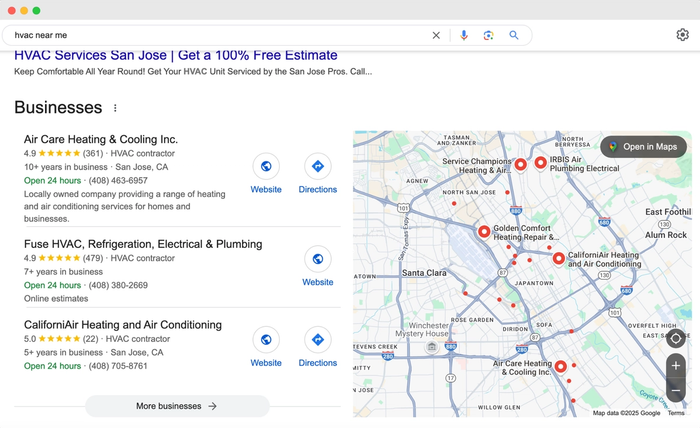
And this is what it looks like after clicking on a specific result:
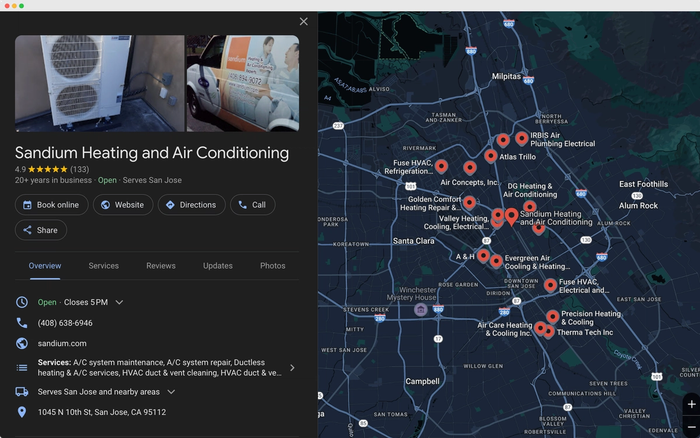
Google Business Profile is completely free and takes only a few minutes to set up.
Setting up and optimizing your Google Business Profile
Start by creating your profile on Google Business Profile and signing in with a Google account linked to your business.
- Once you’re in, add your business name. If it already exists, claim ownership. If not, enter your details from scratch.
- Your business category matters – it tells Google where to place you in searches. Pick the best match for what you do.
- If you have a physical location, add your address so customers can find you on Google Maps. If you don’t have a storefront but serve a specific area, list your service region instead.
Once the basics are set, fine-tune your profile so it stands out:
- List the correct contact details. Add your phone number and website so searchers can reach you instantly.
- Keep your business hours up to date. If hours change for holidays or special events, update them so customers don’t show up to a closed door.
- Upload high-quality photos. A business with photos looks more trustworthy than one without. Show your storefront, products, and even your team at work.
Reviews are the backbone of a strong Google presence. Businesses with more positive reviews rank higher in local searches.
Ask happy customers to leave feedback, and respond to every review – good or bad. A quick reply shows that you’re active and care about your customers' experience.
Once your profile is set up and verified, it works around the clock, bringing in new customers and helping you stand out.
The more complete and active your profile is, the better it will work for you.
Take action: Log in to Google Business Profile today, review your contact details and business hours, and upload at least one new photo of your business. Set a reminder to check your profile bi-monthly.
2. Get more Google & Facebook reviews
Your target customers believe what others say about your business more than anything you say yourself. In fact, over 90% read online reviews before purchase, and more than 75% trust them.
A steady flow of good reviews builds credibility and helps you reach higher in local searches. The trick is to ask at the right moment and make it easy for customers to leave feedback.
Simple ways to ask for reviews
- Send a post-purchase email. A quick follow-up with a friendly message like, 'Thanks for choosing us! We’d love your feedback—leave us a review here.' Add a direct link and save them the trouble of searching for your page.
- Offer a small discount or incentive. A percentage off their next visit or a freebie for leaving a review gives satisfied customers an extra reason to take action. Ensure you’re asking for honest feedback, not only five-star ratings.
- Ask in person after a great experience. If you provided outstanding customer service and they're happy with their purchase, take a moment to say, 'It’d mean a lot if you shared your experience in a review. It helps others know what to expect.' 77% are willing to leave a review when asked politely.
Make it natural and simple, and remind customers how much their feedback helps. Even a handful of solid reviews can make a difference in how new customers see your business.
Want to make the most out of reviews? Read our reputation management guide.
Take action: Send a quick email to five happy customers this week asking for a review. Include a direct link to your Google or Facebook review page.
3. Join local online groups & online communities
Customers trust businesses they see and interact with regularly. Instead of waiting for customers to find you, show up where they already hang out – local Facebook groups, Slack, Whatsapp, Nextdoor, and Reddit communities.
These places are filled with people asking for guidance and seeking help. Your business becomes part of the conversation if you're active.
How to find and join the right groups
Start with Facebook.
- Open Facebook and search for groups related to your city, neighborhood, or industry.
- Look for buy/sell groups, community discussion groups, and local business networks.
- Click Join and answer any membership questions (some groups ask if you're a local or what kind of business you run).
Try Nextdoor.
- Go to nextdoor.com and sign up with your business email.
- Claim your business so everyone in your area can see you.
- Join local discussions where participants ask for recommendations.
Check Reddit.
- Search for subreddits related to your city (e.g., r/Chicago, r/LosAngeles).
- Read the group rules – some don’t allow direct promotion, but you can still join discussions.
- Help out by answering questions and sharing valuable recommendations. You can gain a lot of insights just by reading the posts!
Continue with Slack.
- Search Google for 'Slack group for [your city] entrepreneurs' – many cities have online communities for business owners.
- Visit slack.com/community to look for open groups.
- If you’re in a chamber of commerce or a local business network, ask if they use Slack for discussions.
For WhatsApp, most groups run on invites, but you can still join:
- Check LinkedIn, Facebook, and Reddit – business owners sometimes share invite links in industry discussions.
- Ask fellow entrepreneurs. A quick 'Do you know any business groups on WhatsApp?' can lead to an introduction.
- Attend local networking events. Some groups form after meetups to keep conversations going.
Once you're in, don’t just post ads.
Be part of the community – share local tips and jump into conversations naturally. When potential customers finally see you as a trusted name, they’ll come to you when they need what you sell.
After joining, introduce yourself. A short message works well:
'Hi everyone, I run [your business name], and we [what you do]. Excited to connect!'
Engage with the group. Answer questions and share practical insights. Join discussions when you have something useful to add. Your prospective partners remember businesses that help without expecting anything in return.
If you need more pointers, read our business networking tips.
Take action: Search for three local Facebook groups related to your industry or area right now. Join them, introduce yourself, and contribute to one discussion this week.
4. Run a small business partnership
Bringing in new customers doesn’t always mean spending more on ads. Sometimes, teaming up with other local businesses is all it takes. A smart partnership helps both businesses get in front of new people without competing for the same sales.
- A yoga studio and a juice bar could run a 'Workout & Smoothie' deal – take a class, get a discount on a smoothie next door. The yoga studio gets a great perk to attract members, and the juice bar reaches health-conscious customers who might not have stopped in otherwise.
- A real-world example is Temple Pastries and Broadcast Coffee Roasters in Seattle. They joined forces to open a café in the Central District, where Temple Pastries makes the baked goods, and Broadcast Coffee Roasters supplies the coffee. Customers get fresh pastries and great coffee in one spot, while both businesses grow their audience.
- Marketing partnerships work the same way. Take the partnership between Mayumi Dresses and Daylight Creations. They ran a holiday giveaway where people could win a floral earring from Daylight Creations and a $30 gift card from Mayumi Dresses.
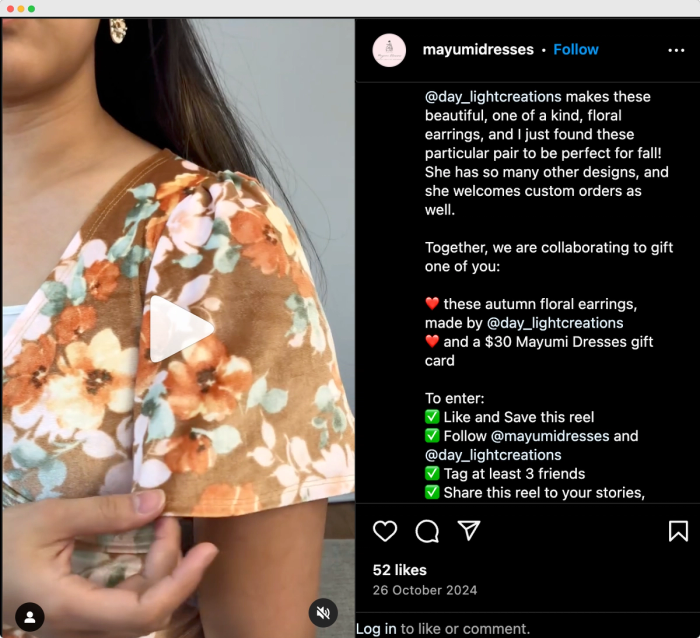
The Slack, WhatsApp, and Facebook groups mentioned earlier can help you connect with potential partners. Business owners often discuss collaborations in these spaces, seeking ways to reach more customers.
Join the conversation, see who serves a similar target audience, and build connections that could lead to a win-win partnership.
Take action: Reach out to one local business this week that complements yours. Propose a simple collaboration like a joint discount or social media giveaway.
5. Host or participate in free community events
According to McKinsey, 88% of customers trust word-of-mouth recommendations the most. Local events are perfect for getting the word out about your business.
Even small meet-ups help people learn about you and keep you at the top of their minds. Sponsoring, speaking at, or attending these events puts you in front of potential customers.
How to get sponsorship opportunities
- Start by looking for events that fit your business. Check sports clubs, charity fundraisers, community fairs, school events, and local networking breakfasts. Many need some support from small businesses and offer affordable sponsorship options.
- Visit their websites or social media pages for sponsorship info. If nothing is listed, contact the organizer and ask how businesses can get involved. Some may accept product donations or a small fee in exchange for exposure.
- When reaching out, keep it short. Introduce your business, explain what you do, and show why you're a good fit for the event. Instead of saying, 'We’d love to be part of this event,' say, 'We’re a local coffee shop and can bring free coffee for volunteers.'
After securing a spot, make your presence count. Set up a booth. Hand out samples. Chat with attendees. A real conversation does more for your business than a logo on a flyer ever will – it helps secure loyal customers.
Looking for event inspiration? Check these 20+ small business event ideas.
Take action: Check your city’s event calendar this week. Reach out to one organizer to ask about sponsorship or vendor opportunities.
6. Hand out business cards and flyers in the right places

Sometimes, the simplest tactics work best.
Handing out business cards and flyers can put your name in front of people who need your services locally. Combine them with modern small business marketing tools, and you're golden.
But leaving flyers anywhere won’t help much. You need to pick spots where your ideal customers already spend time.
Start with complementary businesses.
If you run a hair salon, leave your cards at a local boutique. A pet grooming service? Ask a vet’s office or pet supply store. Business owners often support each other, so don’t be afraid to ask for a little favor!
Flyers work well in places with lots of foot traffic. Coffee shops, community centers, and fitness studios are excellent spots. Don’t stop there, though! Try:
- Libraries – Locals visit for events, study groups, and meetings.
- Apartment buildings – Many have bulletin boards near the mailroom or entrance.
- Farmer’s markets – Ask vendors if you can leave flyers at their booth.
- Gyms – Members look for services that fit their lifestyle, from meal prep to massage therapy.
- Co-working spaces – Freelancers and small business owners often need services like printing, catering, or marketing.
When you drop off flyers or cards, make them easy to grab. A small stack near the register or a pin on the bulletin board works well. And when possible, add a small note or offer, e.g.,: 'Show this card for 10% off your first visit.'
This might feel old-school, but it works. Get out there and entice customers with a reason to call or visit.
Take action: Design and print 100 business cards or flyers if you don’t have them already. You can do it quickly and on your own with tools like Canva.
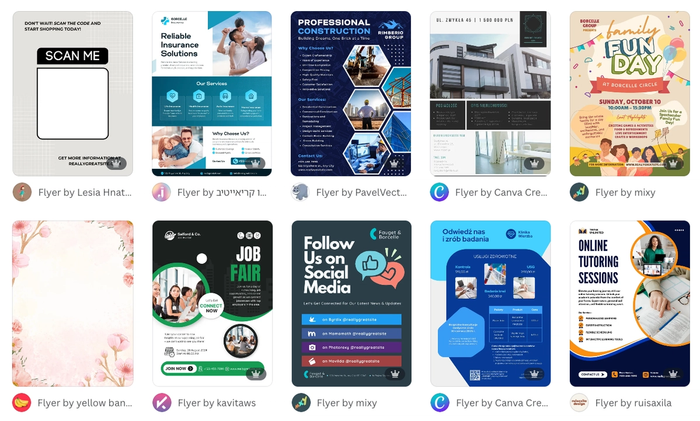
Drop them off at two local businesses or community centers by the end of the week.
7. Offer referral incentives to existing customers
Satisfied customers are your best marketers! A simple referral program gives them a reason to spread the word about your business.
Something as straightforward as, 'Refer a friend and both of you get 10% off your next visit,' works well for restaurants, salons, fitness studios, and service businesses.
Tomlinson Bomberger, a landscaping and pest control company in Lancaster, PA, rewards customers with a $100 in-house credit for every successful referral. Each time a referred friend makes a purchase, the referrer earns another $100:
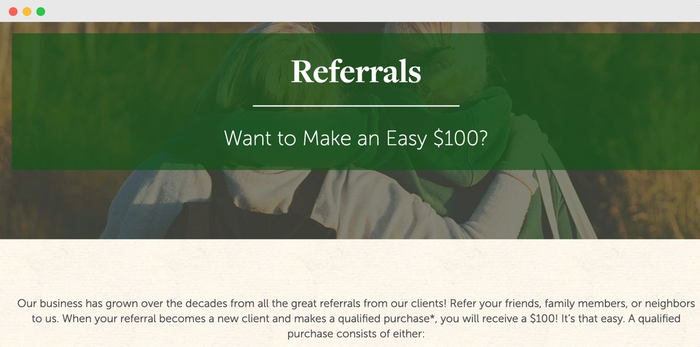
Midwest Heating & Cooling in Wisconsin runs a similar program. They reward customers who recommend their services to friends, family, and neighbors. Their long-standing reputation is built on word-of-mouth, and they give back for every new client referral.
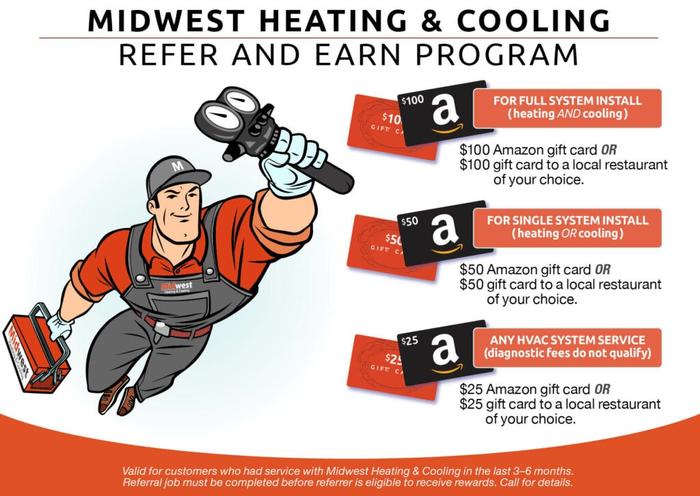
Referral incentives don’t have to be complicated. Offer a slight discount, store credit, gift cards, or free service to thank clients for sending business your way. It’s a simple nudge that can lead to steady growth and help attract customers.
Referrals drive repeat customers, but retention matters, too. Here's how to keep them coming back.
Take action: Create a referral offer today. Post it on your social media and send it to your current customers.
8. Get featured in local online directories
If customers can’t find you online, they’ll find someone else. Listing your business in local directories helps you show up in searches and brings more people to your door.
Start with well-known sites like Yelp, Angi, Bing Places, Chamber of Commerce, and Hotfrog. Also consider Thumbtack, Foursquare, Manta, Local.com, Yellow Pages, and Citysearch.
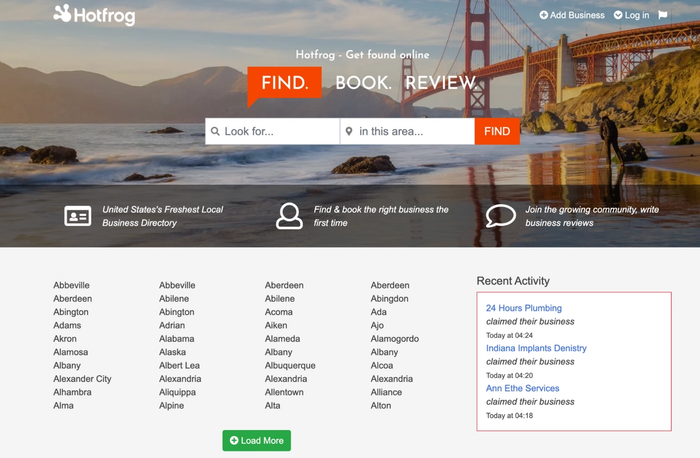
Getting listed is simple:
- Pick directories relevant to your business.
- Go to their site and search for your business. If it’s not listed, click 'Add Business' or 'Claim Business.'
- Enter your business name, contact details, website, and hours. Write a short, clear description of what you do.
- Add high-quality photos. Show your storefront, products, or services.
- Verify your listing. Most sites send a code via email, text, or mail.
Keep your details the same across all platforms. This helps search engines trust your business and makes it easier for customers to find you.
Take action: Start with Yelp. Search for your business and claim your page. If you’re not listed, add your business today.
9. Optimize your website for local SEO
Your website should tell visitors exactly where you are and what you do. Adding your city or town to key elements of your website helps search engines show your business to local customers.
A headline like 'Best Dog Grooming in Brooklyn – Open 7 Days a Week!' does more than just catch attention. It clarifies your location and improves your chances of showing up when someone searches for dog grooming in Brooklyn.
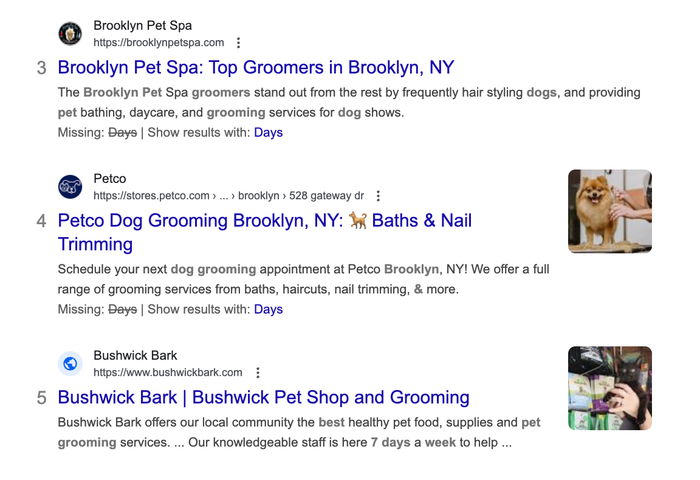
If you're looking for keywords to enhance your titles or content, try using a free tool called Answer the Public. Just enter your industry or main keyword, and it will generate a list of additional keywords and ideas. Then, add these to your content and meta titles, and watch your rankings soar:
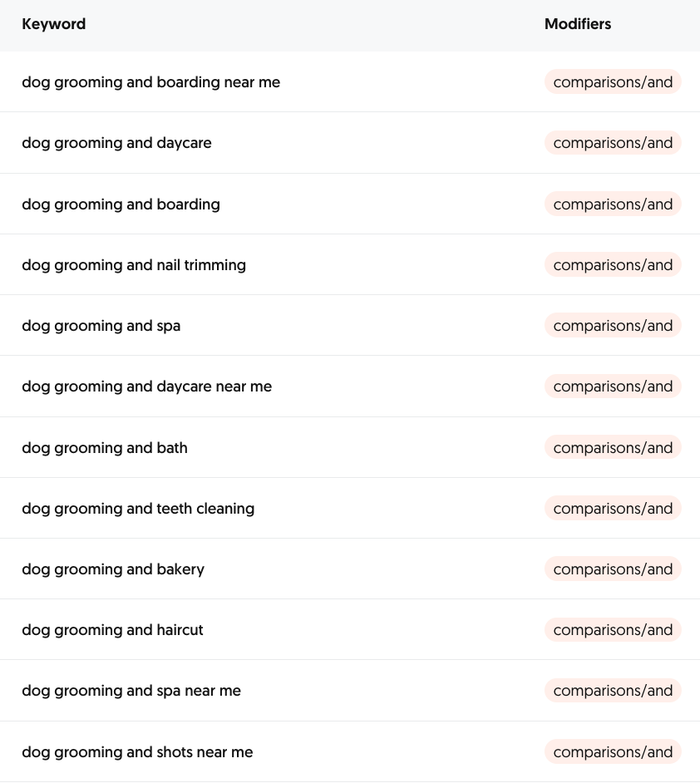
Adding an FAQ section also helps. Use local search terms in your questions and answers. For example:
- Where can I find affordable dog grooming in Brooklyn?
- What’s the cost of dog grooming in Park Slope?
If you’re not sure what questions people are asking, Google can help. Just scroll down to the section called 'People Also Ask.' Answering those questions is a great starting point!
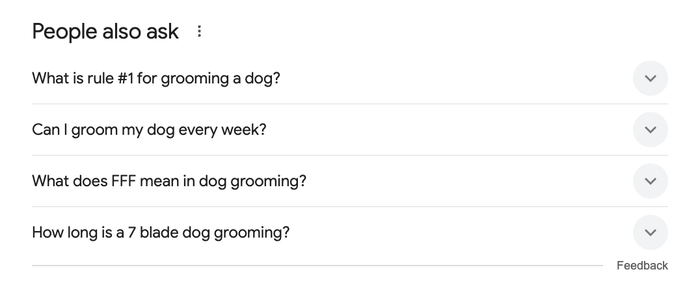
If you need even more inspiration, Answer the Public also provides a few question ideas in the free report you generated earlier.
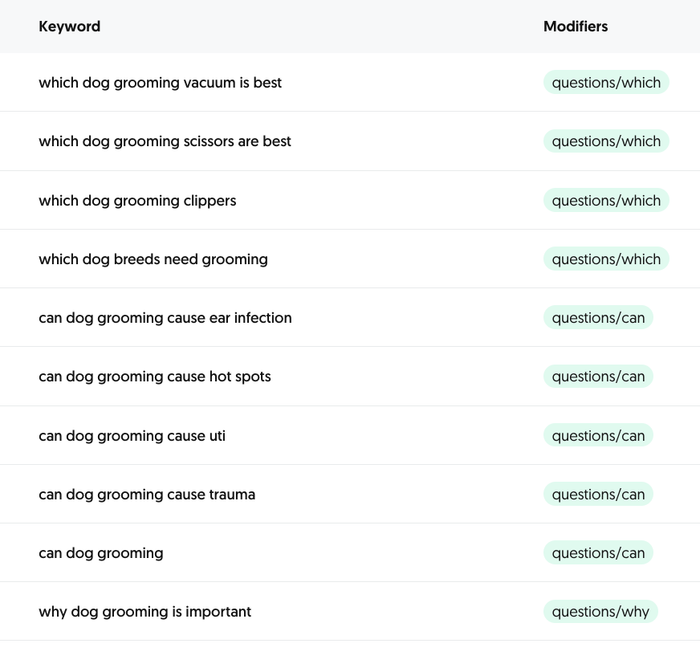
Here are a few things to keep in mind about optimizing your website for local SEO:
- Include your business name, address, and phone number on every page. The footer is often the best place for doing that. Keeping this information consistent across your site and online directories helps search engines trust your business.
- Create a location-specific landing page if you serve more than one area. For example, if you groom dogs in both Brooklyn and Queens, build a separate page for each location with unique content.
- Make sure your site is mobile-friendly. Most local searches happen on phones, so your website needs to load quickly, look good on small screens, and have easy-to-click buttons.
For more information, read our local SEO checklist or watch our webinar about SEO.
These details give search engines more reasons to show your site to nearby customers. They also help answer common questions before anyone even contacts you. Even minor updates like this can make a real difference in how easily your online business can be found.
Take action: Add your business location to your website's homepage and contact page this week. Write one new FAQ with a local keyword by next Friday.
How to get fast results with local marketing
If you want to start seeing results quickly focus on what works best.
- The easiest way to get noticed is to keep your Google Business Profile complete and up to date. This literally puts you on the map and helps potential customers find you when they search for businesses like yours.
- Next, work on getting more reviews. A steady flow of positive feedback builds trust and pushes you higher in search results. Happy customers are usually willing to leave a review – you have to ask.
- Instead of spreading yourself too thin, choose one or two local groups or partnerships to invest your time in. These connections can lead to referrals and new customers.
The key is consistency. Small, consistent efforts add up. Show up in local conversations, stay active in groups, and keep engaging with customers. Over time, your business will become a familiar name in your local community.
Common mistakes to avoid in local marketing
Think your business will grow just by being great at what you do? Not if no one can’t find you! Many local businesses miss out on customers because of simple mistakes. Are you making any of these?
→ Not using Google Business Profile
If your business isn’t on Google, you’re missing out on customers actively searching for exactly what you offer. In fact, it’s often the first impression potential customers have of your business.
A Google Business Profile makes you appear in local searches, Google Maps, and 'near me' results. Competitors take the top spots without it, and potential customers move on.
Setting it up takes minutes, and updating it helps prospects find you, trust you, and choose you over others.
→ Ignoring reviews
People almost always check reviews before making a decision. If your business has only a few or none at all, they’ll pick someone with more feedback. Bad reviews aren’t the problem—ignoring them is. Respond to every review, good or bad. Thank happy customers, and address concerns professionally. Showing that you listen builds trust and makes others more likely to buy from you.
→ Trying too many marketing strategies at once
Local marketing works best when you stay consistent. Spreading your efforts too thin can result in minimal progress in any area. Instead, pick two or three tactics that fit your business, like building partnerships or engaging in local groups.
Execute them well before adding more; a focused approach brings better results than jumping from one strategy to another.
Turn local visitors into loyal customers – make a move today
You don’t need a big budget to attract local customers! With smart, targeted actions, you can do even more. The businesses that win locally aren’t always the biggest; they’re the ones that show up where their customers are.
Pick two or three strategies from this list and start today. Update your Google Business Profile, ask a few happy customers for reviews, or introduce yourself to a local group. Design business cards or send some partnership emails. Little by little, progress builds, and a consistent approach wins over random pushes.
Want a clear plan? Try CapsuleCRM to keep track of your local leads and follow up with potential customers.



